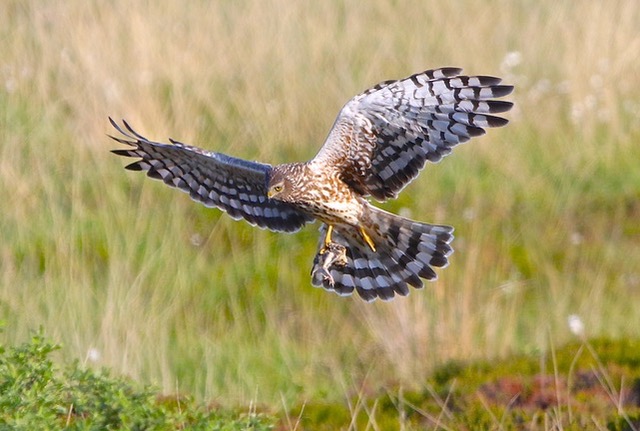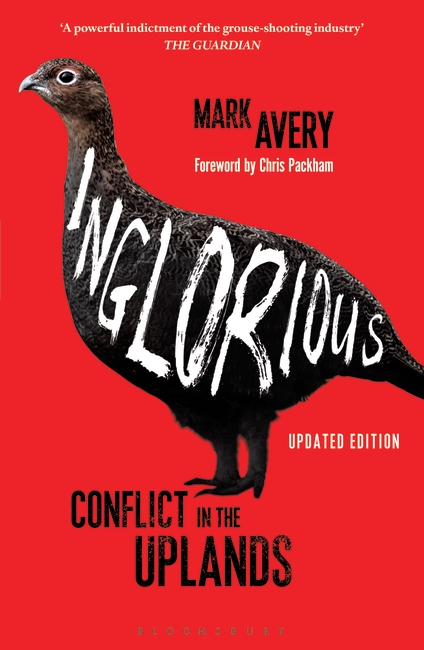
These are some words from Inglorious (written in 2014), they are the imagined words of an ex-gamekeeper writing of the demise of driven grouse shotoing p253-54):
‘In the end, with all that satellite-tag stuff, you could hardly point your shotgun at a bird of prey without fearing it might be a tagged bird that was being monitored in real time by some twenty-year-old babe working for Natural England or the RSPB who would be picking up the phone, in her nice warm office, and phoning the police as soon as the bird  stopped transmitting. I know of a few keepers who’ve said they missed their shot because they had that picture in their heads.
stopped transmitting. I know of a few keepers who’ve said they missed their shot because they had that picture in their heads.
But plenty of tagged raptors bit the dust, or the peat anyway. There was that year in the late 2010s when all those harriers died in the summer and then those eagles in the autumn – it was carnage!
I don’t know how much money was poured into satellite-tagging Hen Harriers but it was money well spent from their point of view. For a while, our side could shrug off the missing birds and keep muttering ‘Tag malfunction, probably tag malfunction’ – but once there were so many tagged in different parts of the country then the pattern was clear for all to see. Birds tagged in Wales did fine, their tags didn’t pack up, unless they travelled to grouse moors in the north of England, and then their lifespan was quite short. Same with the birds on the Isle of Man – safe as houses there, but travel across to Lancashire, or get as far as Yorkshire, and the tags had a high ‘failure rate’. And so many birds were ‘failing’ on grouse-moor areas that even though no one could tell who’d killed them (apart from that prat who was filmed doing it, of course) then there was no ducking the fact.
There had been no ducking the fact anyway, it’s just that it was so much more newsworthy if a known bird, with a known life history of travelling around the country, died in suspicious circumstances. And the RSPB and others weren’t fools – they made sure all the birds were named by the local primary schools – my daughter Eileen was at one of them! – for maximum tear-jerking effect. The birds that survived became interesting characters with their life histories well known, and the ones that disappeared became victims that everyone cared about. Very clever stuff.’
Well, it has taken some time to get there, but we are getting closer and closer to that endpoint. Here is a press release from the RSPB describing the number of Hen Harriers tagged by RSPB, and there are other Hen Harriers that have been tagged by others too.
Over 30 chicks tagged by RSPB project
An unprecedented number of hen harrier chicks have been fitted with satellite tags this year by the RSPB as part of its EU funded Hen Harrier LIFE project to secure the future of these threatened birds.
So far more than 30 of the young birds have been tagged, the majority of them in Scotland. This is the fourth year in a row that the project has fitted satellite tags on hen harrier chicks. A number of those tagged this year are the offspring of birds tagged in previous years by the project including DeeCee who hatched in Perthshire in 2016.
Hen harriers are one of the UK’s rarest birds [Mark writes – not really!] and the satellite tags allow the project to follow their movements as they leave the nest, gaining invaluable information on where the birds spend their time. The odds are stacked against hen harrier chicks from the start with survival rates of around 22 per cent in their first two years of life. The tags can reveal information about the cause of death for many of these young birds.
Of the birds tagged in 2017 almost 40 per cent are known to have died from natural causes, in line with these low survival rates. As the tags continue to transmit after a bird has died the remains of many of them were able to be recovered allowing post mortems to be carried out. These showed some to have been predated, while others died of starvation. One bird, Eric who was tagged in Orkney in July 2017, apparently drowned in January.
However, the tags also reveal that over a quarter of last year’s chicks have disappeared in suspicious circumstances. In these cases, transmissions from tags that have been functioning perfectly suddenly stop. The tag of one bird, Calluna, ended transmissions abruptly over a grouse moor a few miles north of Ballater on 12th August last year. Manu and Marc, from the same Borders nest, both disappeared over grouse moors in northern England.
The latest national survey of hen harriers, carried out in 2016, shows that the UK population has declined by 24 per cent since 2004. In Scotland there has been a 57 per cent decline on grouse moors since 2010. The continued illegal persecution of these birds is having a huge detrimental impact on their numbers.
RSPB Scotland is currently awaiting the recommendations of an independent enquiry panel commissioned by the Cabinet Secretary for the Environment Climate Change and Land Reform, Roseanna Cunningham MSP in May 2017, to look into how grouse moors can be managed within the law and explore options for its regulation. The panel was created following the review of satellite tagged golden eagles in Scotland and is expected to report back in Spring 2019.
Dr Cathleen Thomas, Project Manager for the RSPB’s Hen Harrier LIFE project said, ‘Satellite tagging technology has taught us so much about the movements of hen harriers. We can follow individual stories; from the birds that make huge journeys crossing over seas to those that stay closer to home and only move short distances from where they were hatched. We’ve discovered new nesting places and winter roosting sites, which help us protect the birds when they are at their most vulnerable.
The tags also allow us to investigate where and in what circumstances these hen harrier chicks are lost so we can better understand how to protect them and advocate for licensing of driven grouse shooting. This species is only just holding on in the UK; it’s both heart-breaking and infuriating that year after year many of these chicks disappear in suspicious circumstances. The loss of birds in this way is both needless and senseless and cannot go on. We hope that the recommendations of the enquiry panel here in Scotland will give hen harriers, and other birds of prey, a fair and fighting chance at survival and help stamp out these outdated illegal persecution practices.‘.
The project is grateful for the fantastic support given from members of the Scottish Raptor Study Group and to the many landowners and their staff for their interest and help in assisting to tag so many birds.
From September a selection of this year’s tagged birds will be added to the project website where their travels can be followed along with some of the surviving birds from previous years: www.rspb.org.uk/henharrierlife
Ends
[registration_form]
If the people who used to shoot hen harriers were to stop the practice today, I think problems will still remain. Surely now they have realised that the crime will be detected, even if not solved. The practice of disturbing the birds wishing to breed, already obvious, will still have an impact on breeding success. Perhsps shooting will be missing on driven grouse moors, just as poisoning seems to be much reduced. In designing the scheme Scotland puts forward, I hope they take cognicance of the changing situation.
I think in the current climate on Harriers that we should tag all the young and if that is not possible as many as we can. Despite the claims of Amanda ” if we let them in” Anderson and GWCT even if their breath taking change of heart to love harriers was true ( no I don’t believe then either) there are still the hardcore criminals within the grouse bothering fraternity which wants these birds dead and gone as much as they ever did and that my friends is a great deal. So tagging has several beneficial effects–
1. We learn more about harrier dispersal, survival, and habitat choices
2. It discourages some from killing them
3. It tells us when and where ( roughly) they kill them and thus keeps the pressure on the criminals as they like nothing worse than these crimes are no longer undetected.
I don’t buy all the current crap about it is all down to the harrier emergency recovery plan that it has been a good season for harriers. I think it stems from last years excellent productivity in Southern Scotland, the good weather and the apparently high vole population. however we need to remember that the only birds on privately owned grouse moor failed, a male deserting both his females on eggs seems to me at least unlikely, possible but unlikely and I’ve followed lots of harrier nests. There are still key areas without successful nests or birds that seem traditional the south western moors of UU in Bowland used to hold the bulk of the population and it seems odd they do not now host any nests and the moors on the boundary between the YDNP and Nidderdale AONB used to be another very traditional area for nesting attempts and there are other places too. I for one will breathe easier when these areas again have successful nests, a spread population is a safer population in some ways.
Despite the gushing praise for the harrier plan from Amanda A it has absolutely nothing to do with this years success.
The test is winter and autumn survival and in this persecution is the key, the grouse botherers always maintained that because harriers can and occasionally do nest at high density they needed the safety net of brood meddling to protect their interests. Currently this has been available for two breeding seasons but has not been used because apart from Yorkshire Water only private moors ( I think) will use it but if this is their safety net they need to enforce this amongst their members and others (not us, its entirely down to them) because there should be, even in their terms, no need any longer to kill harriers. If they do the plan has clearly completely failed to deliver.
If we win the judicial case against BM and I hope we do then this is the barrier we need to overcome too and my guess is we need more enforcement, as it can be no coincidence that the most successful years in the last 20 were in the period that the police scheme “Operation Artemis” was working much as the grouse botherers hated it.
Even if we were to solve miraculously the harrier problem or more properly the problem for harriers on grouse moors there is still the widespread killing and breeding prevention of Peregrines, Short-eared Owls, Goshawks and Golden Eagles on grouse moors to get to grips with and of course Mountain Hares.
Tell me Mr Disliker because I’m sure you’re a he what is you don’t like about my comment. Am I factually incorrect, is my analysis wrong, you have a different opinion of the MA or GWCT or you just don’t like harriers and wish to continue or support continuing eradication? I’d love to know but then you will probably stay in the shadows of the internet, daring not to expose you views.